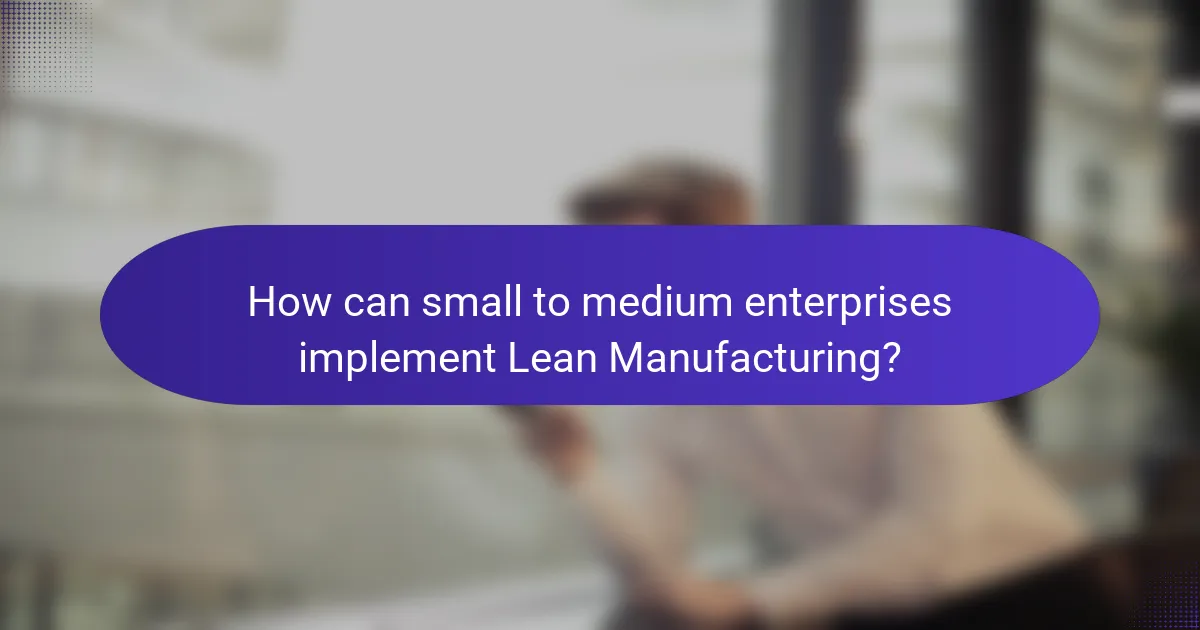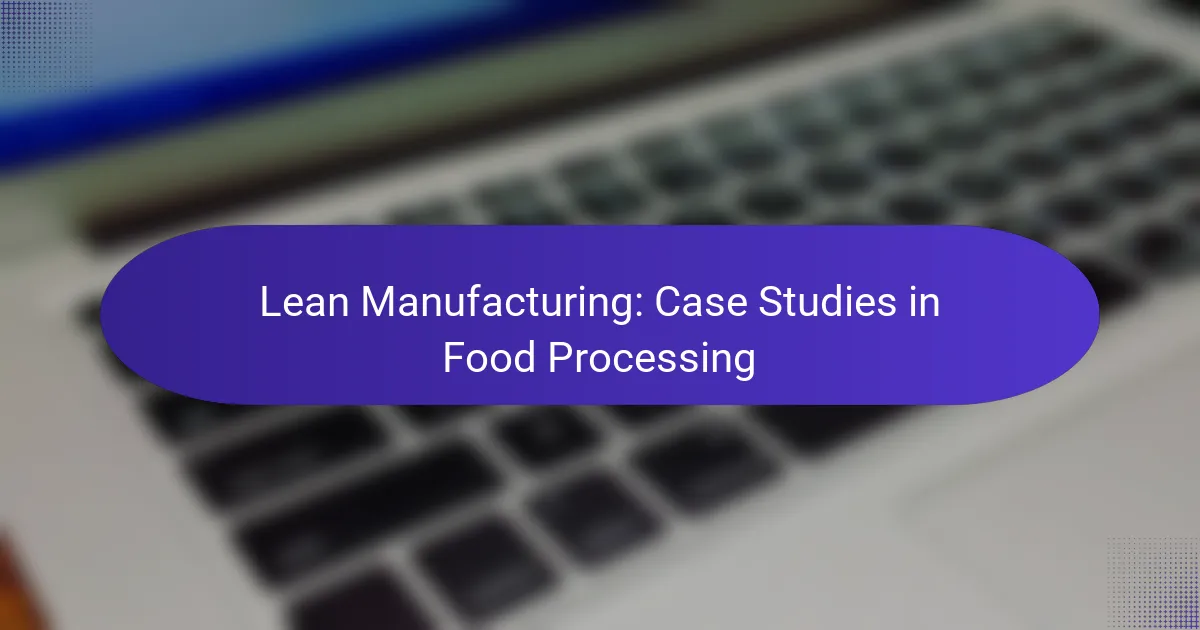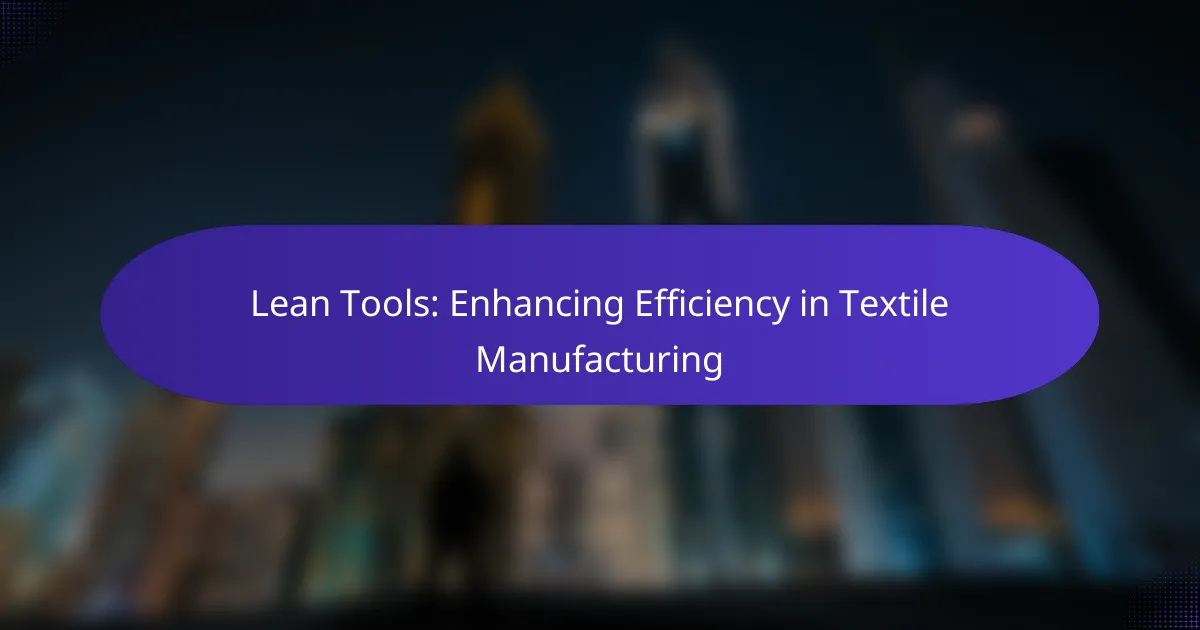Lean Manufacturing provides small to medium enterprises (SMEs) with a powerful framework for enhancing operational efficiency and reducing waste. By adopting methodologies such as 5S, Kaizen, and Value Stream Mapping, SMEs can streamline their processes, lower costs, and improve product quality, ultimately gaining a competitive edge in the market.

How can small to medium enterprises implement Lean Manufacturing?
Small to medium enterprises (SMEs) can implement Lean Manufacturing by focusing on waste reduction and continuous improvement. This approach enhances efficiency, reduces costs, and improves product quality, making it essential for competitive advantage.
Step-by-step implementation guide
To implement Lean Manufacturing, SMEs should start with a thorough assessment of current processes to identify waste. Next, engage employees at all levels in training sessions to foster a culture of continuous improvement. Following this, develop a plan that prioritizes key areas for Lean initiatives and set measurable goals.
Once the plan is in place, begin with small pilot projects to test Lean tools and techniques. Monitor progress and gather feedback to refine processes. Finally, scale successful practices across the organization, ensuring ongoing training and support to maintain momentum.
Key Lean tools for SMEs
Several Lean tools are particularly beneficial for SMEs. Value Stream Mapping helps visualize processes and identify inefficiencies, while 5S (Sort, Set in order, Shine, Standardize, Sustain) promotes organization and cleanliness in the workplace. Kanban systems can also be implemented to manage workflow and inventory effectively.
Additionally, techniques like Kaizen encourage continuous improvement through small, incremental changes. These tools can be adapted to fit the specific needs and resources of SMEs, making them accessible and practical for various industries.
Common challenges and solutions
SMEs often face challenges when implementing Lean Manufacturing, such as resistance to change and limited resources. To overcome these hurdles, it is crucial to communicate the benefits of Lean practices clearly and involve employees in the process from the start.
Another common issue is the lack of time for training and implementation. SMEs can address this by integrating Lean principles into daily operations gradually, rather than attempting a complete overhaul at once. Establishing a dedicated team to lead Lean initiatives can also help maintain focus and drive progress.

What are the benefits of Lean Manufacturing for SMEs?
Lean manufacturing offers small to medium enterprises (SMEs) significant advantages, including reduced costs, improved operational efficiency, and enhanced customer satisfaction. By streamlining processes and eliminating waste, SMEs can achieve better resource utilization and respond more effectively to market demands.
Cost reduction
Implementing lean manufacturing can lead to substantial cost reductions for SMEs by minimizing waste and optimizing resource allocation. This includes cutting unnecessary expenses related to inventory, production, and labor. For instance, businesses can reduce inventory holding costs by adopting just-in-time practices, which align production closely with demand.
To achieve cost savings, SMEs should regularly analyze their processes to identify areas of waste. Common strategies include reducing overproduction, minimizing defects, and optimizing transportation. Tracking these metrics can help businesses realize savings that may range from 10% to 30% of operational costs.
Improved efficiency
Lean manufacturing enhances efficiency by streamlining workflows and eliminating bottlenecks. SMEs can benefit from techniques such as value stream mapping, which helps visualize and improve the flow of materials and information. This can lead to shorter production cycles and faster turnaround times.
To improve efficiency, SMEs should focus on continuous improvement practices, such as the Plan-Do-Check-Act (PDCA) cycle. Regularly reviewing processes and encouraging employee feedback can foster a culture of innovation and responsiveness, ultimately leading to a more agile operation.
Enhanced customer satisfaction
By adopting lean manufacturing principles, SMEs can significantly boost customer satisfaction through higher quality products and faster delivery times. Reducing defects and streamlining processes ensures that customers receive products that meet their expectations consistently.
To enhance customer satisfaction, SMEs should prioritize understanding customer needs and preferences. Implementing feedback loops and actively engaging with customers can provide insights that drive product improvements and service enhancements. This customer-centric approach can lead to increased loyalty and repeat business, which are vital for long-term success.

What Lean Manufacturing methodologies are suitable for SMEs?
Small to medium enterprises (SMEs) can effectively implement several Lean Manufacturing methodologies that enhance efficiency and reduce waste. Key methodologies include 5S, Kaizen, and Value Stream Mapping, each offering unique tools and strategies tailored for smaller operations.
5S methodology
The 5S methodology focuses on organizing and standardizing the workplace to improve efficiency and safety. It consists of five steps: Sort, Set in order, Shine, Standardize, and Sustain. Each step encourages a systematic approach to decluttering and maintaining an organized environment.
For SMEs, implementing 5S can lead to immediate improvements in productivity. For example, a small workshop may reduce time spent searching for tools by up to 30% after organizing workstations. Regular training sessions can help sustain these practices over time.
Kaizen approach
The Kaizen approach emphasizes continuous improvement through small, incremental changes. It encourages all employees to contribute ideas for enhancing processes, which can lead to significant gains in quality and efficiency over time. This method is particularly effective in fostering a culture of teamwork and engagement.
SMEs can implement Kaizen by holding regular brainstorming sessions and encouraging feedback from all staff levels. Simple changes, like adjusting workflow or modifying equipment setup, can yield improvements in production speed and product quality without requiring large investments.
Value Stream Mapping
Value Stream Mapping (VSM) is a visual tool that helps identify and analyze the flow of materials and information in a production process. By mapping out each step, SMEs can pinpoint areas of waste and inefficiency, allowing for targeted improvements. This method provides a clear overview of the entire process, making it easier to communicate changes.
To effectively use VSM, SMEs should involve cross-functional teams to ensure all perspectives are considered. A typical mapping session might reveal that reducing wait times between processes can significantly enhance overall throughput, leading to faster delivery times and increased customer satisfaction.

What resources are available for Lean Manufacturing training?
Various resources exist for Lean Manufacturing training, catering to small and medium enterprises. These include online courses and hands-on workshops, which provide practical knowledge and skills to implement Lean principles effectively.
Online courses from Coursera
Coursera offers a range of online courses focused on Lean Manufacturing, allowing participants to learn at their own pace. These courses typically cover fundamental concepts, tools, and techniques essential for Lean implementation.
Courses often include video lectures, quizzes, and peer-reviewed assignments, making them interactive and engaging. Look for programs that offer certificates upon completion, which can enhance your team’s credentials.
Workshops by Lean Enterprise Institute
The Lean Enterprise Institute (LEI) provides workshops that focus on practical application of Lean principles in real-world scenarios. These workshops are usually led by experienced practitioners who share insights and case studies relevant to small and medium enterprises.
Participants can expect to engage in hands-on activities that reinforce learning, such as value stream mapping and waste identification exercises. Consider attending these workshops for direct interaction and networking opportunities with Lean experts and peers.

How to measure the success of Lean Manufacturing initiatives?
Measuring the success of Lean Manufacturing initiatives involves evaluating specific metrics that reflect efficiency, waste reduction, and overall performance improvements. Key indicators and employee feedback are essential for assessing the effectiveness of these initiatives.
Key performance indicators
Key performance indicators (KPIs) are quantifiable measures that help assess the success of Lean Manufacturing. Common KPIs include cycle time, lead time, overall equipment effectiveness (OEE), and defect rates. For instance, a reduction in cycle time from several hours to low tens of minutes can indicate significant efficiency gains.
When selecting KPIs, focus on those that align with your specific goals. For example, if reducing waste is a priority, tracking scrap rates or inventory turnover can provide valuable insights. Regularly review these metrics to ensure they remain relevant and actionable.
Employee feedback mechanisms
Employee feedback mechanisms are vital for understanding the impact of Lean initiatives on the workforce. Surveys, suggestion boxes, and regular meetings can facilitate open communication about challenges and successes. Gathering insights from employees can highlight areas for improvement that may not be visible through metrics alone.
Implementing a structured feedback process encourages continuous improvement. For example, conducting quarterly feedback sessions can help identify trends and foster a culture of collaboration. Be sure to act on the feedback received to demonstrate that employee input is valued and taken seriously.

What are the prerequisites for adopting Lean Manufacturing?
To successfully adopt Lean Manufacturing, small to medium enterprises need a strong foundation of management commitment and an engaged workforce. These prerequisites ensure that the principles of Lean can be effectively integrated into daily operations.
Management commitment
Management commitment is crucial for Lean Manufacturing implementation. Leaders must actively support Lean initiatives by allocating resources, setting clear goals, and demonstrating a willingness to change existing processes. This commitment fosters a culture that values continuous improvement.
To show commitment, management should participate in Lean training and lead by example. Regular communication about Lean goals and progress can keep the entire organization aligned and motivated. Without this top-down support, Lean efforts may lack direction and momentum.
Employee training and engagement
Employee training and engagement are essential for the successful implementation of Lean Manufacturing. Workers need to understand Lean principles and tools, such as value stream mapping and 5S, to identify waste and improve efficiency. Training should be ongoing to reinforce skills and adapt to new challenges.
Engaging employees in the Lean process can lead to innovative solutions and a sense of ownership. Techniques like cross-functional teams and suggestion programs can encourage participation. Avoid common pitfalls by ensuring that training is relevant and that employees feel their contributions are valued.

How does Lean Manufacturing differ from traditional manufacturing?
Lean manufacturing focuses on maximizing value by minimizing waste, while traditional manufacturing often emphasizes production volume and efficiency without a specific focus on waste reduction. This fundamental difference leads to distinct operational strategies and outcomes.
Focus on waste reduction
In lean manufacturing, waste reduction is a primary goal, targeting any activity that does not add value to the product. This includes overproduction, waiting times, unnecessary transportation, excess inventory, unnecessary motion, defects, and over-processing.
To effectively reduce waste, businesses can implement tools such as Value Stream Mapping to identify and analyze wasteful processes. For example, a small manufacturing firm might discover that a significant amount of time is spent moving materials between workstations, prompting a redesign of the layout to streamline operations.
Common pitfalls include failing to engage employees in the waste reduction process or neglecting to measure the impact of changes. Regularly reviewing and adjusting strategies based on feedback and performance metrics is crucial for sustained improvement.



